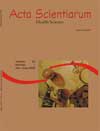<b>Topical antifungals in the treatment of cutaneous mycosis and dandruff</b>- DOI: 10.4025/actascihealthsci.v31i2.6760
Keywords:
antifungal, cutaneous mycoses, dandruff
Abstract
Superficial mycoses are among the main reasons for dermatological consultations, and dandruff is a common complaint of the majority of individuals at a given moment in life; such problems are caused and aggravated by fungi. With the objective of verifying what the demand is and which main antifungal drugs are used in dermatological products, all external use formulations produced at a prescription pharmacy in Londrina, Paraná State, during the first semester of 2006, were evaluated in this study. Among the different products, antifungals were the most requested, representing 17.19% of production. The most used active principles were: ketoconazole, zinc pyrithione, miconazole and gentian violet. During the months of February and March, a significant increase in demand was observed, especially on those products containing ketoconazole and miconazole. This suggests that in the summer, probably due to the heat and to the great frequency of people in swimming pools and beaches, the occurrence of mycoses is favored and, therefore, hygienic care should be redoubled. The increase in the incidence of fungal infections verified in the last decades should be a stimulus to search for new effective antifungal agents with fewer adverse effects and with low cost to help in the treatment of such cutaneous alterations.Downloads
Download data is not yet available.
Published
2009-09-17
How to Cite
Rabito, M. F., & Truiti, M. C. T. (2009). <b>Topical antifungals in the treatment of cutaneous mycosis and dandruff</b>- DOI: 10.4025/actascihealthsci.v31i2.6760. Acta Scientiarum. Health Sciences, 31(2), 107-111. https://doi.org/10.4025/actascihealthsci.v31i2.6760
Issue
Section
Pharmacy
DECLARATION OF ORIGINALITY AND COPYRIGHTS
I Declare that current article is original and has not been submitted for publication, in part or in whole, to any other national or international journal.
The copyrights belong exclusively to the authors. Published content is licensed under Creative Commons Attribution 4.0 (CC BY 4.0) guidelines, which allows sharing (copy and distribution of the material in any medium or format) and adaptation (remix, transform, and build upon the material) for any purpose, even commercially, under the terms of attribution.
Read this link for further information on how to use CC BY 4.0 properly.























5.png)







